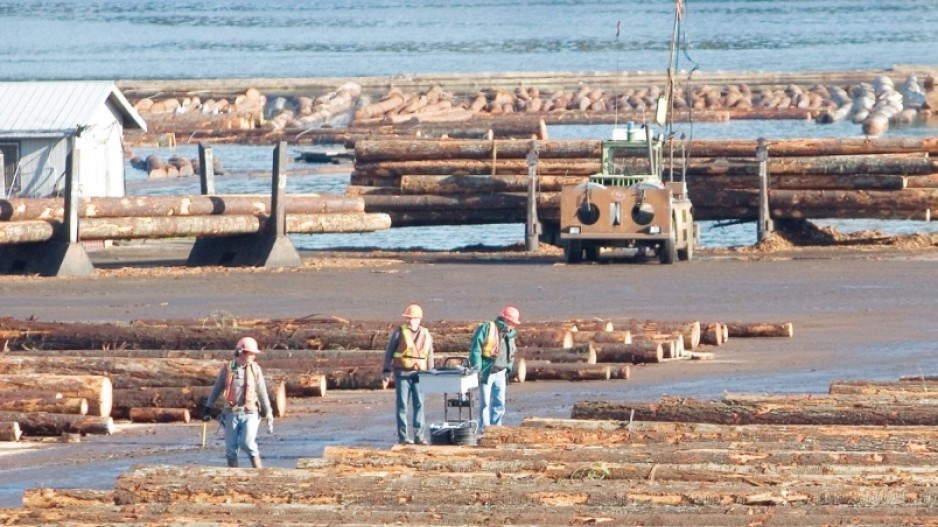B.C. lumber producers experienced a bit of a lift in the fourth quarter in an otherwise awful year marked by low lumber prices, and are bracing for trade volatility in the year to come.
Western Forest Products Inc. (TSX:WEF), West Fraser Timber Co. (TSX,NYSE:WFG) and Interfor Corp. (TSX: IFP) released fourth quarter and annual financials this week that show somewhat improved sales numbers in the fourth quarter of 2024, but overall net losses for the full year.
In its fourth quarter and annual financials, Western Forest Products Thursday announced an “improved” fourth quarter and fiscal 2024 results compared to the same period last year.
Western Forest Products reported positive EBITDA (earnings before interest, taxes, depreciation and amortization) of $14.4 million in the fourth quarter of 2024, compared to negative EBITDA $1.2 million in Q4 2023, and negative $10.7 million in the Q3 2024
The net loss for Western Forest Products in 2024 was $34.5 million, compared to $70 million in 2023. The net loss for the most recent fourth quarter was $1.2 million, compared to a net loss of $14.3 million in Q4 2023.
Western Forest Products noted Q4 prices for cedar lumber were up to $1,467 per thousand board feet, compared to $1,313 in Q4 2023.
“Despite challenging markets, we were successful in returning our business to positive EBITDA in 2024,” said Steven Hofer, President and CEO of Western Forest Products.
Going forward, the company is bracing for tariffs on top of duties, and warning its customers that that the increases will be passed onto them.
The company already pays 14.4 per cent anti-dumping duties, and should U.S. President Donald Trump make good on threats to impose across-the-board tariffs, they will be layered on top of the duties.
“We have informed customers of our intention to pass on the incremental U.S. tariff,” the company said in its year-end financials. “The potential implementation and duration of the incremental U.S. tariff is unknown and could have a material impact on our operating earnings and cash flows.”
West Fraser Timber Co. (TSX,NYSE:WFG) reported a loss of US$62 million on US$1.4 billion in sales in the fourth quarter, and a loss of US$5 million on US$6.2 billion in sales for the full year of 2024.
West Fraser noted a “modest improvement” in the fourth quarter on its lumber segment.
According to Madison's Lumber Reporter, the price for spruce-pine-fir (SPF) two-by-four lumber averaged US $412 per thousand board feet in 2024, up slightly from US$398 in 2023. Current SFP prices for February are at US$445 per thousand board feet.
"Relatively high mortgage rates remain an affordability challenge for consumers and housing markets, impacting demand for our wood building products,” said West Fraser CEO Sean McLaren. “Further, potential for the U.S. administration to impose broad-based tariffs on Canadian exports adds another element of demand uncertainty for the products we ship to the U.S. from Canada.”
Interfor Corp. (TSX: IFP) reported a fourth quarter net loss of $49.9 million, compared to a net loss of $105 in Q3 2024, and $169 million in Q4 2023.
Interfor recorded a net loss of $304 million in 2024 on $3 billion in sales, and a net loss of $267 million in 2023.
Lumber sales from the company’s B.C. operations in 2024 were $660 million, compared to $1.8 billion from its sawmills in the U.S. south, and $1 billion from its sawmills in Eastern Canada.
Interfor paid $3.1 million in duties in the fourth quarter and has, to date, has paid cumulative duties of US$593.6 million, as of December 31, 2024.
Interfor says the outlook for 2025 is “volatile,” but notes it is hedged somewhat against duties through both product and regional “diversification.” The company notes that 60 per cent of the lumber it produces and sells is in the U.S.
“Overall, the company is well positioned with a diversified product mix in Canada and the U.S., with approximately 60 per cent of its total lumber produced and sold within the U.S. Ultimately, only about 26 per cent of the company’s total lumber production is exported from Canada to the U.S.”
“Over the mid-term, Canadian lumber is expected to remain a key source of supply to meet U.S. needs, as growth in U.S. lumber manufacturing capacity will likely be limited by labour constraints, lengthy equipment lead-times and extended project ramp-up schedules.”



